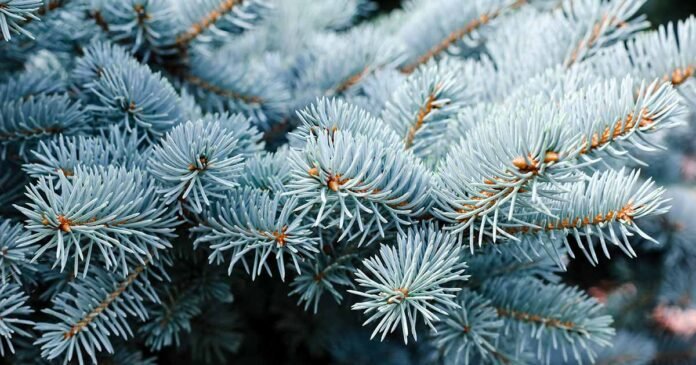Cultivars to Select
Visit just about any nursery and you’re likely to find several blue spruce cultivars available as well as the species plant.
On that note, if you want to grow the species, you can find plants available at Fast Growing Trees.
Here are a few standout cultivars to consider:
Baby Blue
‘Baby Blue’ has everything you love about a Colorado blue spruce in a petite, semi-dwarf package. It tops out at just 15 to 25 feet tall and up to 15 feet wide.
This cultivar maintains the classic pyramidal shape and features extremely vivid needles that are even bluer than those of the species.
You can find ‘Baby Blue’ plants available from Fast Growing Trees.
Blue Wonder
If your main interest is the distinctive color of a Colorado blue spruce, then ‘Blue Wonder’ should be at the top of your list.
It shares all the typical characteristics of the species, though it tends to stay a bit smaller.
This cultivar has bright gray-blue needles that are especially vibrant and guaranteed to stand out in the landscape.
You can find ‘Blue Wonder’ available at Fast Growing Trees.
Baker’s
Baker’s blue spruce (P. pungens var. glauca ‘Bakeri’) has more of a columnar shape than your typical spruce and it’s also far more petite.
Perfect for a smaller landscape, this one will mature to a perfectly manageable 30 feet tall and just 15 feet wide.
Grower R. Ellery Baker of Hiti Nurseries in Pomfret, Connecticut discovered this seedling in Massachusetts in the late 1920s and developed it for commercial release in 1933.
Want one? Nature Hills Nursery has this beauty in #5 containers.
Fastigiata
‘Fastigiata’ is a semi-dwarf cultivar with an upright, columnar growth habit that gradually tapers through the top third of the tree, giving it a somewhat pyramidal silhouette.
It typically grows up to 15 feet tall and about five feet wide, making it a smart choice for narrow spaces in the garden. Just be sure to give it enough room to reach its mature size.
The needles tend to retain their blue color more reliably than many other cultivars, and certainly more consistently than the species. It’s also hardier than most, withstanding conditions as cold as USDA Zone 2.
While the exact origin is unclear, ‘Fastigiata’ has been available in Canada since 1989 and the U.S. since 1993.
Fat Albert
The well-respected Iseli Nursery in Boring, Oregon – renowned for breeding unique and interesting conifers – is credited with introducing ‘Fat Albert’ in the 1970s.
Founder Jean Iseli said that he found the natural hybrid in a field of seedlings, and he was clearly onto something!
Despite the name, ‘Fat Albert’ isn’t particularly wide. It reaches up to 45 feet tall and 20 feet wide at most. The name is a nod to the popular cartoon character, not its shape.
This cultivar features that perfect pyramidal shape and striking silver foliage.
It’s particularly slow growing and long lived, so it can be a highlight in your garden for decades (even centuries) to come.
If you want a tried-and-true option with the perfect shape, bring home ‘Fat Albert’ from Fast Growing Trees.
Globe
For a truly dwarf option, there’s nothing better than the glorious Globe (Picea pungens var. glauca ‘Globosa’).
This compact cultivar reaches just five feet tall and six feet wide at maturity, with a naturally rounded shape that requires no pruning to maintain.
It’s one of those set-it-and-forget-it plants you can enjoy for years without lifting a finger.
Bred by Luis’ Nursery in Boskoop, Holland, in 1937, it was later refined and introduced by Le Feber & Company in 1955.
Clearly, they were onto a hit as this cultivar has become the go-to choice for gardeners wanting a dwarf blue spruce, especially one with a bushy, compact habit.
If that sounds like you, visit Fast Growing Trees where you can find plants available in five-gallon pots.
Slenderina
So far, we’ve talked about upright spruce and one cute little shrub. But I’m a total sucker for a weeping tree, so I’d be remiss to skip the lovely ‘Slenderina.’
I have grown this gorgeous weeper in several of my gardens and it is always the one that draws stares and comments.
‘Slenderina’ grows to about 15 feet tall and about half as wide, with pendulous, weeping branches that can also twist and turn as they emerge from the central trunk.
You can even train the main trunk itself to curve and twist, too. I once saw one trained into a half arch as the entrance to a wisteria tunnel and it was magnificent!
You can find ‘Slenderina’ available at Nature Hills Nursery.
Maintenance
You don’t need to prune a Colorado blue spruce regularly.
The only time you’ll need to bring out the pruners is if a branch dies, is damaged by pests, or doesn’t fit the overall shape you’re aiming for.


The best time to prune is in late winter while the tree is still dormant – just avoid doing so when temperatures are below freezing.
Use loppers, a saw, or hand pruners to remove unwanted branches. Cut as close as possible to the adjoining branch or trunk.
There’s no need to seal the wound, the tree will do that on its own with the sticky resin common to spruces, pines, and firs.
Learn more about pruning conifers here.
Fertilizing is typically unnecessary unless your young tree appears stunted or unhealthy.









